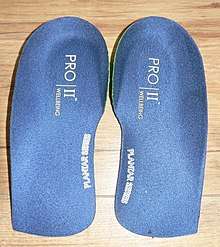Shoe insert
A removable shoe insert, otherwise known as a foot orthosis, insole or inner sole accomplishes many number of purposes, including daily wear comfort, height enhancement, plantar fasciitis treatment, arch support, foot and joint pain relief from arthritis, overuse, injuries, leg length discrepancy, and other causes such as orthopedic correction and athletic performance.


Medical use of foot orthoses has been criticized as lacking evidence of benefit, and practice is very inconsistent: reputed podiatrists prescribe completely different orthoses for a single patient.[1][2] Further, effect of a given design of orthosis varies significantly by patient, and standard practice to personalize prescription is not available.[3] However, evidence is mixed: patients often report at least short-term improvements in comfort, and other studies have found effectiveness.[4]
Fitting patients
There are three standard methods for fitting patients: plaster casts, foam box impressions, or three-dimensional computer imaging. None are very accurate: all produce proper fit under 80% of the time.[5][6]
Traditionally they were created from plaster casts made from the patient's foot. These casts were made by wrapping dipped plaster or fiberglass strips around the foot to capture the form, then letting it dry and harden. Once the cast was hardened, the doctor would carefully remove it from the patient's foot and ship it, along with a prescription, to an orthotics lab which would use the negative of the cast to create an orthopedic insert.
Recently, several companies have developed digital foot scanners that use specialized software to scan a patient's foot and create a "virtual" cast. These scans are made by having the patient place the foot onto a specialized flat image scanner that uses light and software to capture and create a 3D model. This 3D model is then electronically submitted (along with a prescription) to an orthotics lab, where it is used to program a CNC machine that will ultimately produce the orthopedic insert.
Diabetic shoes
Diabetic shoes, sometimes referred to as extra depth, therapeutic shoes or Sugar Shoes, are specially designed shoes, intended to reduce the risk of skin breakdown in diabetics with co-existing foot disease.
See also
Further reading
- Razeghi, Mohsen; Batt, Mark Edward (2000). "Biomechanical analysis of the effect of orthotic shoe inserts". Sports Medicine. 29 (6): 425–38. doi:10.2165/00007256-200029060-00005. PMID 10870868.
- Landorf, K.B.; Keenan, A.M. (2000). "Efficacy of foot orthoses. What does the literature tell us?". Journal of the American Podiatric Medical Association. 90 (3): 149–58. doi:10.7547/87507315-90-3-149. PMID 10740997. S2CID 23374568.
- Christovão, TC; Neto, HP; Grecco, LA; Ferreira, LA; Franco de Moura, RC; Eliege de Souza, M; Franco de Oliveira, LV; Oliveira, CS (Oct 2013). "Effect of different shoe inserts on postural balance: a systematic review". Journal of Physical Therapy Science. 25 (10): 1353–6. doi:10.1589/jpts.25.1353. PMC 3820199. PMID 24259792.
- Penny, P; Geere, J; Smith, TO (Oct 2013). "A systematic review investigating the efficacy of laterally wedged shoe inserts for medial knee osteoarthritis". Rheumatology International. 33 (10): 2529–38. doi:10.1007/s00296-013-2760-x. PMID 23612781.
References
- Nigg, Benno M. (2011). Biomechanics of Sports Shoes.
- Kolata, Gina (January 17, 2011). "Close Look at Orthotics Raises a Welter of Doubts". The New York Times.
- Nigg, Benno M.; Stergiou, PRO; Cole, Gerald; Stefanyshyn, Darren; m??Ndermann, Anne; Humble, Neil (2003). "Effect of Shoe Inserts on Kinematics, Center of Pressure, and Leg Joint Moments during Running". Medicine & Science in Sports & Exercise. 35 (2): 314–319. doi:10.1249/01.MSS.0000048828.02268.79. PMID 12569222.
- Gross, M. L.; Davlin, L. B.; Ebanski, P. M. (1991). "Effectiveness of orthotic shoe inserts in the long-distance runner". American Journal of Sports Medicine. 19 (4): 409–412. doi:10.1177/036354659101900416. PMID 1897659.
- Ingraham, Paul (December 22, 2014). "Orthotics Review: A consumer's guide to the science and controversies of orthotics, special shoes, and other (allegedly) corrective foot devices". Missing or empty
|url=(help) - Telfer S.; Gibson KS; Hennessy K; Steultjens MP; Woodburn J. (2012). "Computer-aided design of customized foot orthoses: reproducibility and effect of method used to obtain foot shape". Arch Phys Med Rehabil. 93 (5): 863–70. doi:10.1016/j.apmr.2011.12.019. PMID 22541310.